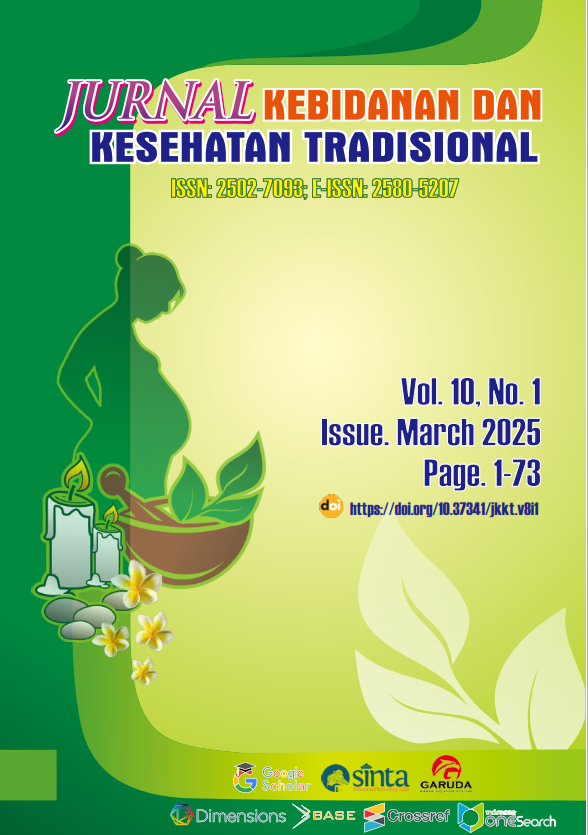Breastfeeding Self-Efficacy Related to Postpartum Depression Tendency
Main Article Content
Abstract
Background: Postpartum depression (PPD) is a psychological disorder that is related to insecure relationships, mother-child bonding disorders, and also has an impact on increasing the risk of maternal suicide. Breastfeeding self-efficacy (BSE) is related to physical and psychological adjustment in postpartum mothers and is one of the factors that can influence postpartum depression, plus breastfeeding is one of the main tasks of every postpartum mother. The purpose of this study was to analyze the relationship between breastfeeding self efficacy and tendency of postpartum depression at PMB S Blimbing District, Malang City, Indonesia.
Methods: The study had used correlational analytic design with a cross sectional. The number of samples were 48 people, done by quota sampling technique. The tool of collecting data was questionnaire by Breastfeeding Self Efficacy Scale-Short Form (BSES-SF) and Edinburgh Postnatal Depression Scale (EPDS). Analysis data procedure was using spearman correlation test.
Results: Data showed the age range of respondents were 20-35 years(83.3%); senior high school (50%); not working (75%); multipara (77.1%); high breastfeeding self efficacy (66.7%); not tendency of postpartum depression (81.2%); and respondent with high BSE who experienced not tendency of PPD (66.6%). The result showed there was a relationship between breastfeeding self efficacy and tendency of postpartum depression (p=0.000).
Conclusion: Based on result of study, it is known that respondent who have high BSE came from respondents who not tendency of PPD. It means that BSE is one of the factors that can influence postpartum depression and it is impotant to scale up.
Article Details
How to Cite
References
Asmalinda, W., Miskiyah, Clarasani, N., Setiyawati, D., Sapada, E., Fatimah, S., Daimah, U., & Estiani, M. (2022). Nifas sebuah periode transisi. Literasi Nusantara Abadi.
Azad, R., Fahmi, R., Shrestha, S., Joshi, H., Hasan, M., Khan, A. N. S., Chowdhury, M. A. K., Arifeen, S. El, & Billah, S. M. (2019). Prevalence and risk factors of postpartum depression within one year after birth in urban slums of Dhaka, Bangladesh. PLoS ONE, 14(5). https://doi.org/10.1371/journal.pone.0215735
Desiana, W., & Tarsikah, T. (2021a). Screening of post partum depression on the seventh day puerperium. Indonesian Midwifery and Health Sciences Journal, 5(2), 198–208. https://doi.org/10.20473/imhsj.v5i2.2021.198-208
Desiana, W., & Tarsikah, T. (2021b). Screening of postpartum depression on the seventh day puerperium. Indonesian Midwifery and Health Sciences Journal, 5(2), 198–208. https://doi.org/10.20473/imhsj.v5i2.2021.198-208
Dini Afriani, & Shinta Amelia Febriani. (2024). Stunting prevention is Alan effort to reduce the risk of stunting. ABDIMAS: Jurnal Pengabdian Masyarakat, 7(3), 871–876. https://doi.org/10.35568/abdimas.v7i3.4832
Fathi, F., Mohammad-Alizadeh-Charandabi, S., & Mirghafourvand, M. (2018). Maternal self-efficacy, postpartum depression, and their relationship with functional status in Iranian mothers. Women and Health, 58(2), 188–203. https://doi.org/10.1080/03630242.2017.1292340
Fattah, H. (2017). Kepuasan kerja dan kinerja pegawai (Cetakan 1). Penerbit Elmatera.
Gondo, H. K. (2012). Skrining Edinburgh Postnatal Depression Scale (EPDS) pada postpartum blues. Jurnal Imliah Kedokteran, 01(2), 1–14.
Hahn-Holbrook, J., Cornwell-Hinrichs, T., & Anaya, I. (2018). Economic and health predictors of national postpartum depression prevalence: A systematic review, meta-analysis, and meta-regression of 291 studies from 56 countries. Frontiers in Psychiatry, 8(February). https://doi.org/10.3389/fpsyt.2017.00248
Hairol, M. I., Ahmad, S., Sharanjeet-Kaur, S., Wee, L. H., Abdullah, F., & Ahmad, M. (2021). Incidence and predictors of postpartum depression among postpartum mothers in Kuala Lumpur, Malaysia: A cross-sectional study. PLoS ONE, 16(11 November), 1–12. https://doi.org/10.1371/journal.pone.0259782
Hajjan, M. (2023). Faktor yang berpengaruh terhadap kejadian postpartum blues. In L. Amalia, T. Niswatin, & E. Dewi (Eds.), Seminar Nasional Keperawatan Nasional (pp. 16–23). Universitas Muhammadiyah Surakarta.
Krol, K. M., & Grossmann, T. (2018). Psychological effects of breastfeeding on children and mothers. Bundesgesundheitsblatt - Gesundheitsforschung - Gesundheitsschutz, 61(8), 977–985. https://doi.org/10.1007/s00103-018-2769-0
Kroska, E. B., & Stowe, Z. N. (2020). Postpartum depression: identification and treatment in the clinic setting. Obstetrics and Gynecology Clinics of North America, 47(3), 409–419. https://doi.org/10.1016/j.ogc.2020.05.001
Medforth, J., Ball, L., Walker, A., Battersby, S., & Stables, S. (2017). Oxford handbook of midwifery (3rd ed.). Oxford University Press.
Mercan, Y., & Selcuk, K. T. (2021). Association between postpartum depression level, social support level and breastfeeding attitude and breastfeeding self-efficacy in early postpartum women. PLoS ONE, 16(4 April 2021), 1–12. https://doi.org/10.1371/journal.pone.0249538
Minamida, T., Iseki, A., Sakai, H., Imura, M., Okano, T., & Tanii, H. (2020). Do postpartum anxiety and breastfeeding self-efficacy and bonding at early postpartum predict postpartum depression and the breastfeeding method? Infant Mental Health Journal, 41(5), 662–676. https://doi.org/10.1002/imhj.21866
Munisah, M., Ika, R., Yuliati, L., & Hanum, D. F. (2021). Faktor-faktor yang mempengaruhi terjadinya depresi pascapersalinan. IJMT : Indonesian Journal of Midwifery Today, 1(1), 1. https://doi.org/10.30587/ijmt.v1i1.3318
Nurhayati, N. (2017). Cortisol : Bendungan ASI dan maternity blues : Kajian berbasis riset. Media Nusa Creative.
Putri, N. K. S. E., & Hastutik. (2019). Hubungan tingkat pendidikan ibu dengan breastfeeding self efficacy di wilayah kerja Puskesmas Bulu Kabupaten Sukoharjo. Jurnal MATERNAL, 3(1), 1–10.
Restarina, D. (2017). Skripsi: Gambaran tingkat depresi ibu postpartum di wilayah kerja Puskesmas Ciputat Timur kota Tangerang Selatan tahun 2017. Universitas Islam Negeri Syarif Hidayatullah.
Solama, W., Rivanica, R., Effendi, E., & Safitri, S. (2023). Analisis karakteristik ibu nifas tentang depresi post partum. Jurnal ’Aisyiyah Palembang, 8(1), 300–313. https://doi.org/https://doi.org/10.36729/jam.v8i1.1008
Suparwati, I., Murwati, & Suwanti, E. (2018). Hubungan antara kelancaran pengeluaran ASI dengan kejadian postpartum blues di wilayah Puskesmas Trucuk II Klaten. Jurnal Kebidanan Dan Kesehatan Tradisional, 3(1), 8–13.
Vieira, E. de S., Caldeira, N. T., Eugênio, D. S., Di Lucca, M. M., & Silva, I. A. (2018a). Breastfeeding self-efficacy and postpartum depression: A cohort study. Revista Latino-Americana de Enfermagem, 26. https://doi.org/10.1590/1518-8345.2110.3035
Vieira, E. de S., Caldeira, N. T., Eugênio, D. S., Di Lucca, M. M., & Silva, I. A. (2018b). Breastfeeding self-efficacy and postpartum depression: A cohort study. Revista Latino-Americana de Enfermagem, 26(e3035), 1–8. https://doi.org/10.1590/1518-8345.2110.3035
Vitasari, D., Sabrian, F., & Ernawaty, J. (2018). Hubungan dukungan keluarga terhadap efikasi diri ibu menyusui dalam memberikan ASI eksklusif. Jurnal Online Mahasiswa (JOM), 05(02), 201–210.
WHO. (2019). MhGAP Intervention Guide for Mental Neurological and Substance-use Disorders in non-specialized Health Settings : Mental health Gap Action Programme (mhGAP). World Health Organization.
Wurisastuti, T., & Mubasyiroh, R. (2020). Prevalensi dan prediktor depresi pasca persalinan: Data komunitas Riskesdas 2018. Prosiding Seminar Nasional Kesehatan Masyarakat.

